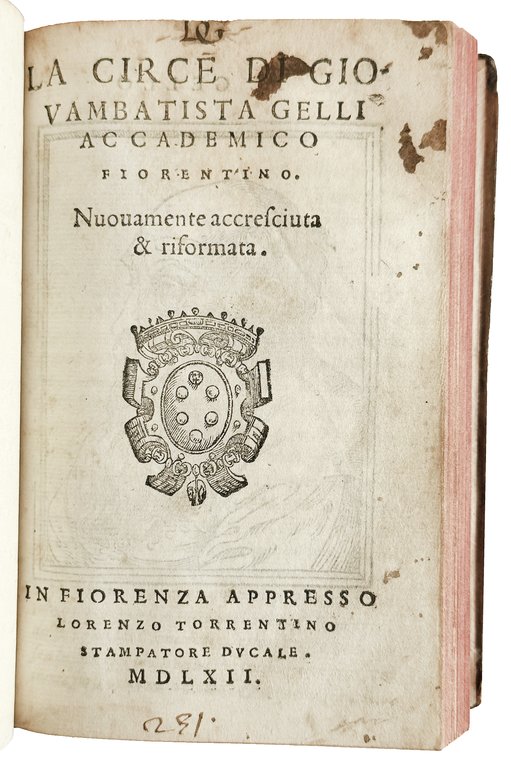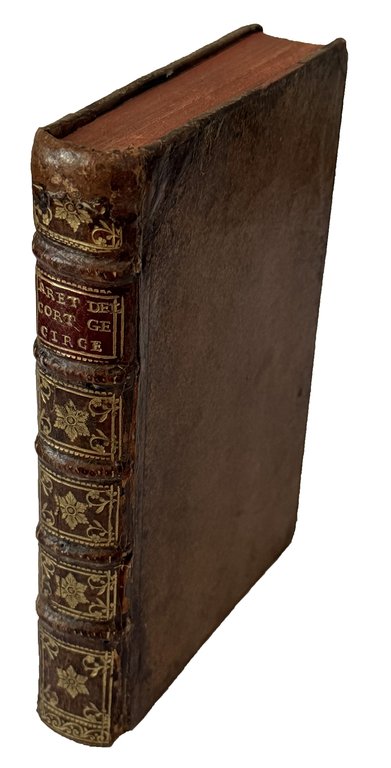


Libri antichi e moderni
ARETINO, Pietro (1492-1556)
Ragionamento nel quale Pietro Aretino figura quattro suoi amici. Che favellano de le corti del mondo, & di quella del cielo. N.pl., n. pr., n.d. [not before 1538]
5800,00 €
Govi Libreria Antiquaria
(Modena, Italie)
Le corrette spese di spedizione vengono calcolate una volta inserito l’indirizzo di spedizione durante la creazione dell’ordine. A discrezione del Venditore sono disponibili una o più modalità di consegna: Standard, Express, Economy, Ritiro in negozio.
Condizioni di spedizione della Libreria:
Per prodotti con prezzo superiore a 300€ è possibile richiedere un piano rateale a Maremagnum. È possibile effettuare il pagamento con Carta del Docente, 18App, Pubblica Amministrazione.
I tempi di evasione sono stimati in base ai tempi di spedizione della libreria e di consegna da parte del vettore. In caso di fermo doganale, si potrebbero verificare dei ritardi nella consegna. Gli eventuali oneri doganali sono a carico del destinatario.
Clicca per maggiori informazioniMetodi di Pagamento
- PayPal
- Carta di Credito
- Bonifico Bancario
-
-
Scopri come utilizzare
il tuo bonus Carta del Docente -
Scopri come utilizzare
il tuo bonus 18App
Dettagli
Descrizione
Rare early edition. The Ragionamento nel quale Pietro Aretino figura quattro suoi amici, che favellano delle corti del mondo, e di quella del cielo, also know as “Ragionamento delle Corti”, which was first published by Francesco Marcolini in 1538, is related for style and satirical intent to the famous Aretino's erotic Ragionamenti or Dialoghi featuring the characters of Nanna, Antonia, and Pippa and printed between 1534 and 1536. The work subsequently underwent at least six reprints, including the present edition, all of which are extremely rare, before being included in the London-based typographer John Wolf 1584 collected edition of all Aretino's Ragionamenti.
In the present Ragionamento, Aretino “completely overturns Castiglione's utopia, condemning the figure of the intellectual-courtier, who is no longer the enlightened advisor to a prince who embodies all virtues, but an individual devoted to intrigue, lies, and the constant pursuit of personal gain [...] The court is described as a terrible place, where vice and corruption reign under the constant threat of violence. At court (so declares one of the characters in the Ragionamento), one lives in familiarity with death. The reversal is completed when, in the Ragionamenti, Aretino replaces the discussion of the qualities of the perfect courtier with those of the perfect prostitute, as if the two figures mirrored each other” (G. Montinaro, L'utopia rovesciata di Aretino, in: “Biblioteca di via Senato”, IV, 2011, p. 7).
In the “Ragionamento delle Corti”, divided into two parts, the author presents some of his friends conversing in the famous Venice garden of the printer Francesco Marcolini, who was a close friend of Aretino and the editor of all of his works in the 1530s and 1540s. The interlocutors are Lodovico Dolce, Francesco Coccio and Pietro Piccardi in both parts, and Giovanni Giustiniani who appears only in the second.
Pietro, the son of Tita Bonci and a cobbler named Luca Del Tura, was born in Arezzo in the momentous year 1492. With typical disregard for propriety, he sometimes claimed to be the bastard of the nobleman Luigi Bacci, who kept his mother as a mistress. In all his publications, however, he adopted the nom d'artiste Pietro Aretino. He received little education and lived, for some years poor and neglected, picking up such straps of information as he could. Still very young he was banished from Arezzo on account of a satirical sonnet which he composed against indulgences. About 1506 he moved to Perugia, where he obtained the protection of Francesco Bontempi. In that town he also got acquainted with many poets and painters, among them Agnolo Firenzuola, who became a partner in his many dissolute adventures. In those years he wrote a collection of poems, Opera nova (Venezia, Zoppino, 1512), his first published work. After a brief stay in Siena, where he was serving Agostino Chigi, he settled in Rome in 1517 and entered the refined court of Leo X. Like his friend Bernardo Accolti, called Unico Aretino, Pietro became soon very popular for his audacity and effrontery that made him both loved for the laugh and sympathy he communicated, and respected for fear of falling victim to his terrible satirical tongue. He was able to become the confidant of politicians and diplomats and close friend of artists and poets. From them he gathered a wealth of anecdotes and secrets, which he used to put himself at the center of Roman social life. Aretino had to flee briefly in 1524 after publishing some sonnets to go with a series of banned engravings by Giulio Romano showing positions adopted in love-making; and once more, this time permanently, in 1525, when the chief target of his pen, Bishop Gian Matteo Giberti - a man Clement could not afford to offend publicly - nearly succeeded in having him assassinated. To the end of the Roman period and the beginning of hi

